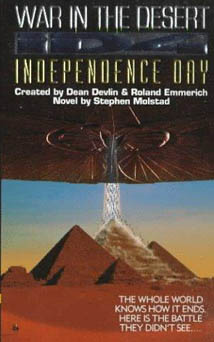To celebrate the 20th anniversary of “Independence Day” and the release of the sequel, “Resurgence,” this week I’m looking back at the various spinoff comics and novels. All of these spin-off materials were recently released (or re-released, in the case of the old stuff) by Titan Books. Also, check out my reviews of “Independence Day” and “Independence Day: Resurgence.”
When the Earth militaries brought down the 36 city destroyers at the end of “Independence Day” (one is shown, the other 35 are implied), there were three possibilities: 1) The chain-reaction explosion and crash would kill all the aliens aboard, 2) Some would survive, but the mop-up duty would be relatively easy, or 3) Many would survive, and they would fight back. In at least one location, the third scenario occurs, as chronicled in Stephen Molstad’s sidequel/sequel “War in the Desert” (1999).
Taking place before, during and after July 4, 1996, this is the most personal “ID4” story so far, but oddly, it doesn’t feature any major “ID4” characters. It does technically feature two characters from the movie, though: Reginald Cummins and Thomson, two British pilots stationed in Saudi Arabia. They’re the ones who exchange this dialog upon getting a Morse code communication over the radio:
“It’s from the Americans. They want to organize a counteroffensive.”
“It’s about bloody time.”
“War in the Desert” doesn’t have particularly meaty character arcs, but it has colorful and distinct personalities. In a breezy way, it shows how people of different nationalities, races and religions get together to fight the aliens. The team of pilots — and later, ground forces – that gathers under Reg includes a Palestinian and an Israeli who become friends, and a traditionalist Saudi man who begins to respect a female British soldier. Saudi woman Fadeela is a possible love interest for Reg, and Molstad does a good job of showing how Muslim tradition makes a relationship almost impossible, even if both desire one: Contact between the genders is pretty much prohibited.
Molstad keeps this action-oriented story tense as our heroes have to deal with human villains, namely the Saudi commander Faisal, who has the support of the king and desires his own glory.
In a “Raiders of the Lost Ark”-style way, “War in the Desert” gives a flavor of locations such as the Empty Quarter, an unlivable portion of the desert in Saudi Arabia, as well as a taste of town life and airbase life in the country. For a perhaps too-long stretch, Reg and company have to wait at a remote outpost before Faisal decides on a course of action.
A third of the way through the novel, the humans take out the city destroyer that had destroyed Jerusalem, and it conveniently turns away from its second target, Mecca, to crash in the desert. For whatever reason, this ship is less damaged than the one that targeted Area 51, and that leads to the meatiest part of the book, because tons of aliens survive the crash and we learn a lot about their biology and technology through fights in the desert and through the soldiers’ “Rendezvous with Rama”-style treks through the downed ship; these missions also have a bit of an “Aliens” flavor.

Among the bio-tech, the aliens have organic ground vehicles called chariots, which can be driven by the mental will of two people, owing to the hive-mind nature of the culture. They have plasma rifles that are embedded in the arm shell of the outer alien (the small aliens, the ones doing the thinking, live inside and control the exoskeletons); these can be fired by two people agreeing on the target. (In “Resurgence,” it seems the aliens prefer hand-held plasma rifles.) The aliens have medallions in their hands that serve as compasses. And we meet a second batch of aliens, the Tall Ones, who are the same white color as the small ones, but higher in the hierarchy. We see that the aliens grow their shells, vehicles and every part of the ship in cloning vats.
Doubling down on the theme of humans destroying ourselves, which runs as an undercurrent through “ID4” in the form of David Levinson’s enviro-rants, the aliens acquire biological weapons from a Saudi military lab. If dispersed into an underground river, this human-created weapon will wipe out humanity.
At 351 pages, “War in the Desert” is longer than it needs to be, but it’s still a page-turner. Molstad wheels a reader from the ragtag group’s internal personality politics to military strategies to revelations about the alien technology and way of life. It’s not a particularly deep story, but it is logistically complex, so I give the author credit for always being clear about what’s going on. The novel is a treasure trove of information on the aliens. Perhaps Devlin and Emmerich decided three years after the movie’s release was long enough to wait before getting this info to “ID4” die-hards.
One downside of the novel is that, aside from the Morse code communication as seen in the film, there’s no communication between this group of human warriors and the other 35 groups tasked with taking out city destroyers. It might’ve been neat to have a cameo from a major film character, or from Captain Joshua Adams (William Fichtner’s character in “Resurgence”), who we now know coordinated the worldwide counteroffensive in the days after the attack. Presumably the Saudi Arabia human resistance was cut off from Adams’ communications more so than the other 35 groups. This would make sense due to the relative remoteness of the location.
“War in the Desert” enriches the franchise by answering a ton of questions, but it raises a lot more and leaves them on the shelf until 17 years later, when the “Resurgence” tie-in materials would revisit the lore.

